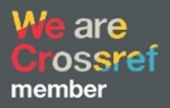PENGENALAN CIRI SUARA SEBAGAI PERINTAH KONTROL ARAH PADA MOBILE ROBOT BERBASIS MIKROKONTROLER STM32F4
DOI:
https://doi.org/10.51804/tesj.v4i2.800.35-42Keywords:
instruksi suara, mobile robot, pengenalan ciri suara, perintah kontrol arah, stm32f4Abstract
Teknologi robotika merupakan salah satu teknologi yang sangat dibutuhkan untuk menunjang revolusi industri 4.0. Pengontrolan arah pada mobile robot sangat dibutuhkan agar robot dapat melakukan kegiatan sesuai dengan rancangan yang diinginkan. Dalam pengontrolan arah robot dibutuhkan suatu metode yang praktis dan efisien. Kontrol arah dengan perintah suara berdasarkan pengenalan ciri suara diusulkan pada penelitian ini agar robot dapat bergerak sesuai dengan instruksi pengguna tanpa harus menyentuh robot sehingga metode ini diharapkan mampu mempermudah pengguna dalam memberikan perintah kontrol arah pada mobile robot. Dengan menggunakan metode modified Euclidean Distance yang digunakan untuk mencari jarak terdekat pada ciri input suara berdasarkan referensi suara sehingga dapat dilakukan pengenalan pola suara sebagai perintah kontrol arah pada mobile robot. Metode ini diaplikasikan pada mikrokontroler STM32F4 sebagai kontroler pada mobile robot. Perintah kontrol arah yang digunakan yaitu ‘maju’, ‘mundur’, ‘kiri’, ‘kanan’ dan ‘stop’. Diperoleh rata-rata tingkat keberhasilan 84% dalam pengenalan perintah kontrol arah pada mobile robot berdasarkan pengenalan ciri suara.References
Alka, N. U., Salihu, A. A., Haruna, Y. S., & Dalyop, I. A. (2017). A Voice Controlled Pick and Place Robotic Arm Vehicle using Android Application. American Journal of Engineering Research (AJER), 6(7), 207-215.
Gumilar, Z. A., dan Lubis, D. (2017). Rancang Bangun Sistem Autonomous Pada Robot Beroda dengan Global Positioning System (GPS). Seminar Nasional Kelautan XII. Surabaya: Fakultas Teknik dan Ilmu Kelautan Universitas Hang Tuah.
Gundogdu, K., Bayrakdar, S., & Yucedag, I. (2018). Developing and modeling of voice control system for prosthetic robot arm in medical systems. Journal of King Saud University – Computer and Information Sciences, 30, 198-205.
Lumenta, A. S. M. (2012). Pemanfaatan Komputer Tablet Android Sebagai Pengendali Robot Beroda Empat. e-journal Teknik Elektro dan Komputer UNSRAT, 1(4), 1-7.
Memon, Y. A., Motan, I., Akbar, M. A., Hameed, S., & Hasan, M. U. (2016). Speech Recognition System for A Voice Controlled Robot with Real Time Obstacle Detection and Avoidance. International Journal Of Electrical, Electronics And Data Communication, 4(9), 33-37.
Rashid, H., Ahmed, I. U., Osman, S. B., Newaz, Q., Rasheduzzaman, Md., & Reza, S. M. T. (2017). Design and Implementation of a Voice Controlled Robot with Human Interaction Ability. International Conference on Computer, Communication, Chemical, Materials and Electronic Engineering. Rajshahi: University of Rajshahi Bangladesh.
Riyani, A., Nurrochman, A., Sanjaya, E., Rizqiyah, P., & Junaidi, A. (2019). Mengidentifikasi Sinyal Suara Manusia Menggunakan Metode Fast Fourier Transform (Fft) Berbasis Matlab. Journal of Informatics, Information System, Software Engineering and Applications, 1(2), 42-50.
Rizaldi, R., Kurniawati, A., & Angkoso, C. V. (2018). Implementasi Metode Euclidean Distance untuk Rekomendasi Ukuran Pakaian pada Aplikasi Ruang Ganti Virtual. Jurnal Teknologi Informasi dan Ilmu Komputer (JTIIK), 5(2), 129-138.
Sulistyo, E. (2017). Mobile Robot dengan Pengontrolan Perintah Suara Berbasis Android. Jurnal Manutech, 9(2), 9-14.
Downloads
Published
Issue
Section
License
With the receipt of the article by TESJ Editorial Board and the decision to be published, the copyright regarding the article will be transferred to TESJ. The copyright transfer form can be downloaded here.
TESJ has the right to multiply and distribute the article, and every author is not allowed to publish the same article published in this journal.

Teknika: Engineering and Sains Journal is licensed under a Creative Commons Attribution 4.0 International License.
Under the following terms:
Attribution — You must give appropriate credit, provide a link to the license, and indicate if changes were made. You may do so in any reasonable manner, but not in any way that suggests the licensor endorses you or your use.
.jpg)


